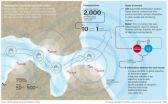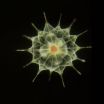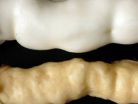(Press-News.org) Palo Alto, CA—Geologists have found evidence that some 55 million years ago a river as big as the modern Colorado flowed through Arizona into Utah in the opposite direction from the present-day river. Writing in the October issue of the journal Geology, they have named this ancient northeastward-flowing river the California River, after its inferred source in the Mojave region of southern California.
Lead author Steven Davis, a post-doctoral researcher in the Department of Global Ecology at the Carnegie Institution, and his colleagues* discovered the ancient river system by comparing sedimentary deposits in Utah and southwest Arizona. By analyzing the uranium and lead isotopes in sand grains made of the mineral zircon, the researchers were able to determine that the sand at both localities came from the same source -- igneous bedrock in the Mojave region of southern California.
The river deposits in Utah, called the Colton Formation by geologists, formed a delta where the river emptied into a large lake. They are more than 400 miles (700 kilometers) to the northeast of their source in California. "The river was on a very similar scale to the modern Colorado-Green River system," says Davis, "but it flowed in the opposite direction." The modern Colorado River's headwaters are in the Rocky Mountains, flowing southeast to the river's mouth in the Gulf of California.
The deposits of the Colton Formation are approximately 55 million years old. Recently, other researchers have speculated that rivers older than the Colorado River may have carved an ancestral or "proto" Grand Canyon around this time, long before Colorado began eroding the present canyon less than 20 million years ago. But Davis sees no evidence of this. "The Grand Canyon would have been on the river's route as it flowed from the Mojave to Utah, he says. "It stands to reason that if there was major erosion of a canyon going on we would see lots of zircon grains from that area, but we don't."
The mighty California River likely met its end as the Rocky Mountains rose and the northern Colorado Plateau tilted, reversing the slope of the land surface and the direction of the river's flow to create the present Colorado-Green River system. Davis and his colleagues have not determined precisely when the change occurred, however. "The river could have persisted for as long as 20 million years before the topography shifted enough to reverse its flow," he says.
INFORMATION:
* Authors: Steven J. Davis, Carnegie Institution; William R. Dickinson, University of Arizona; George E. Gehrels, University of Arizona; Jon E. Spencer, Arizona Geological Survey; Timothy F. Lawton, New Mexico State University; and Alan R. Carroll, University of Wisconsin.
The Carnegie Institution (carnegiescience.edu) has been a pioneering force in basic scientific research since 1902. It is a private, nonprofit organization with six research departments throughout the U.S. Carnegie scientists are leaders in plant biology, developmental biology, astronomy, materials science, global ecology, and Earth and planetary science. The Department of Global Ecology, located in Stanford, California, was established in 2002 to help build the scientific foundations for a sustainable future. Its scientists conduct basic research on a wide range of large-scale environmental issues, including climate change, ocean acidification, biological invasions, and changes in biodiversity.
Ancient Colorado river flowed backwards
2010-10-05
ELSE PRESS RELEASES FROM THIS DATE:
An eye for an eye
2010-10-05
Revenge cuts both ways in the Israeli-Palestinian conflict. Scientists of the University of Zurich, the Massachusetts Institute of Technology, and Tel Aviv and Quinnipiaq Universities show that attacks by either side lead to violent retaliation from the other. Both Israelis and Palestinians may underestimate their own role in perpetuating the conflict.
A team of scientists from the University of Zurich, the Massachusetts Institute of Technology, and Tel Aviv and Quinnipiaq Universities have found that attacks by both Israel and Palestinians lead to violent retaliation ...
When docs counsel weight loss, it's style that makes a difference
2010-10-05
DURHAM, N.C. – Most doctors are spending a good deal of time counseling their patients about diet and weight loss, but for the most part, it isn't making any difference, according to a new study appearing in the American Journal of Preventive Medicine.
Duke University Medical Center researchers recorded the conversations between 40 primary care physicians and 461 of their overweight or obese patients over an 18-month period. Investigators didn't tell them what they were listening for – only that they wanted to record the encounters to see how doctors talked about health. ...
Researchers find possible biomarker to identify seizure-related stress
2010-10-05
PROVIDENCE, RI -- New research from Rhode Island Hospital found that reduced levels of brain-derived neurotrophic factor (BDNF), a protein in the brain that encourages growth of neurons, may be a trait marker for individuals with psychogenic non-epileptic seizures (PNES) (seizures that are psychological in origin). The findings are published in the October 4, 2010, issue of Neurology, the medical journal of the American Academy of Neurology.
Past studies have shown decreased levels of BDNF in the serum of patients with psychiatric disorders such as major depressive disorder ...
An intelligent system for maritime surveillance has been created
2010-10-05
The system has been designed by scientists from this Madrid university for Núcleo CC, a company which develops surveillance systems for the maritime and aeronautic sectors. The first prototype will be used in the near future in Cape Verde (Africa). Two types of sensors have been deployed there: a set of radars and a series of AIS (Automatic Identification System), which allow ships to communicate their position and give other relevant data on their location and characteristics. These two types of sensors offer complementary data which can be fused in order to obtain better ...
MBL scientists reveal findings of World Ocean Microbe Census
2010-10-05
LONDON, UK—After a decade of joint work and scientific adventure, marine explorers from more than 80 countries, including six scientists from the Marine Biological Laboratory (MBL), today delivered the first global Census of Marine Life revealing what, where, and how much lives and hides in the world's oceans. In one of the largest scientific collaborations ever conducted, more than 2,700 scientists spent over 9,000 days at sea on more than 540 expeditions gathering the data.
As a result of these efforts the scientists discovered that there may be up to 1 billion kinds ...
New report examines university management of intellectual property
2010-10-05
WASHINGTON — The system put in place by the Bayh-Dole Act of 1980 -- which gives universities significant control over intellectual property associated with the results of federally funded research at their institutions – has been more effective than the pre-1980 system in making research advances available to the public and spurring innovation, says a new report from the National Research Council. Nevertheless, the current system needs improvement, said the committee that wrote the report.
"The public investment in research universities has led to a great deal of new ...
Surprise: Scientists discover that inflammation helps to heal wounds
2010-10-05
A new research study published in The FASEB Journal (http://www.fasebj.org) may change how sports injuries involving muscle tissue are treated, as well as how much patient monitoring is necessary when potent anti-inflammatory drugs are prescribed for a long time. That's because the study shows for the first time that inflammation actually helps to heal damaged muscle tissue, turning conventional wisdom on its head that inflammation must be largely controlled to encourage healing. These findings could lead to new therapies for acute muscle injuries caused by trauma, chemicals, ...
Technology transfer and postdoc entrepreneurs
2010-10-05
Post-doctoral researchers see their role as being vital in technology transfer where scientific findings become useful to the local economy, but most have little interest in running their own business once their research fellowship ends. That's the surprising finding of a study published in the International Journal of Knowledge-Based Development.
Edmund Zolnik, a public policy specialist at the George Mason University, in Arlington, Virginia, has surveyed postdoctoral fellows in the US National Capital Region. He found that most saw technology transfer as an important ...
Mechanism involved in addictions and some forms of obesity discovered in U of A lab
2010-10-05
A researcher from the Faculty of Medicine & Dentistry at the University of Alberta has discovered a mechanism underlying some forms of obesity and addictions which could lead to a treatment for both diseases.
When a hungry animal finds food in the wild, it is a rewarding stimulus for the animal and is recognized by the brain by the release of the chemical messenger dopamine. Because narcotics such as cocaine, heroin and amphetamines, and even tasty and highly-caloric foods also cause the release of dopamine and therefore make people feel rewarded, it's clear that dopamine ...
Using cassava to address vitamin A deficiency
2010-10-05
The roots of cassava (Manihot esculenta) serve as the primary source of carbohydrates in the diets of people in many arid regions of the world, including more than 250 million people in sub-Saharan Africa. Unfortunately the roots of commercial cassava cultivars are quite low in micronutrients, and micronutrient deficiencies are widespread in these regions. In addition to programs designed to deliver vitamin supplements, there has been considerable effort aimed at biofortification; that is, increasing the amounts of available micronutrients in staple crops such as cassava. ...



